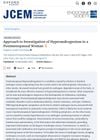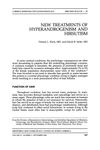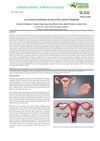TLDR A woman's severe insulin resistance improved with treatment, but she still had high testosterone levels due to ovarian issues.
A 49-year-old African American woman developed type B insulin resistance at age 45, requiring up to 1800 units of insulin daily. She also experienced oligomenorrhea, excessive hair growth, and elevated serum testosterone levels. Treatment with rituximab, dexamethasone, and cyclophosphamide significantly reduced her insulin needs, but her testosterone levels remained high, indicating persistent hyperandrogenism. Postmenopausal status was confirmed by elevated serum FSH levels, and imaging revealed ovarian abnormalities. The case suggested that high insulin levels stimulated ovarian thecal cells, leading to hyperthecosis, and the patient was referred for bilateral oophorectomy.
 November 2022 in “The Journal of Clinical Endocrinology and Metabolism”
November 2022 in “The Journal of Clinical Endocrinology and Metabolism” Postmenopausal hyperandrogenism, a condition with symptoms like increased hair growth and acne, is usually caused by PCOS but can also be due to other factors. It's diagnosed by checking testosterone levels and treated either by removing the adrenal tumor or through antiandrogen therapy.
 1540 citations
,
October 2008 in “Fertility and Sterility”
1540 citations
,
October 2008 in “Fertility and Sterility” The report concludes that PCOS is mainly a condition of excess male hormones and its definition may change as new information is discovered.
 9 citations
,
September 2000 in “Obstetrics and gynecology clinics of North America”
9 citations
,
September 2000 in “Obstetrics and gynecology clinics of North America” Hirsutism causes significant psychological distress in women.
 75 citations
,
June 1999 in “Pediatric Clinics of North America”
75 citations
,
June 1999 in “Pediatric Clinics of North America” The document concludes that early recognition and treatment of PCOS in adolescents is crucial for managing symptoms and long-term health risks.
 1 citations
,
June 2019 in “Innovare journal of medical sciences”
1 citations
,
June 2019 in “Innovare journal of medical sciences” Polycystic Ovary Syndrome (PCOS) is a hormonal disorder in women that can cause infertility and other health issues, and it may be improved by treatments that increase insulin sensitivity.





